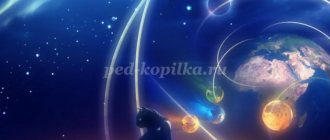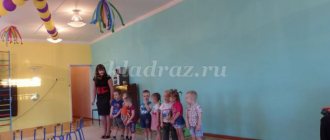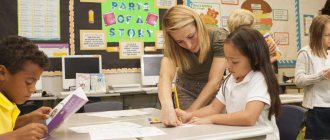Summary of an open lesson on cognitive development in the senior group on the topic “Autumn”
Lesson on cognitive development in kindergarten in the senior group.
Theme: "Autumn". Abstract with presentation Purpose: to summarize children’s knowledge on the topic “Autumn.” Objectives: Educational:
• Clarify and expand children's knowledge about the autumn season.
• Improve your ability to listen carefully and answer questions. • To form in children ideas about the periods of autumn and their characteristic features, a generalized idea of the forest and trees in the autumn period. • Learn to select leaves for a tree. Develop attention and thinking. Developmental:
• Develop children's cognitive interest, their attention and memory.
• Develop interest in completing tasks. • Develop a culture of verbal communication between children and each other and the teacher. Educational:
• To instill in children a caring attitude towards nature.
Integration of educational areas: “Cognitive development”, “Speech development”, “Socio-communicative development”, “Artistic and aesthetic development”, “Physical development”. Preliminary work: - Observations of living and inanimate nature. — Examination of paintings and reproductions about autumn. - Reading fiction. - Memorizing poems, guessing riddles. Equipment: TV, ball, audio recordings with tasks from Autumn, the sound of the autumn forest, cardboard leaves for the path, baskets with pasted images of trees, hoops for “bumps”, gouache, Whatman paper, brushes, jars of water, napkins.
Progress of GCD
Children stand on the carpet in a circle. Educator. Hello guys, look how beautiful it is in our group, and for our journey to be fabulous and exciting, first we need to greet each other, we stand together in a circle, repeat everything after me: Hello golden sun (arms to the sides)
Hello blue sky
( hands up)
Hello free breeze
(we swing our hands over our heads)
Hello little friend
(they take each other’s hands)
.
Educator . And now guys, listen to what I’m going to tell you: This morning they sent me an audio message, but to find out who it’s from, you need to listen to it (turn on the audio recording with the riddle)
: At the edge of the forest I mixed paints, I quietly ran a brush over the leaves.
The hazel tree turned yellow, and the maples stripped, and the birch leaves turned golden. Children. Autumn. Educator. Yes, this is a message from Autumn (slide with autumn screensaver)
.
Audio recording. Guys, I have prepared interesting tasks for you, and in order to complete them, I invite you to the autumn forest. Educator. Well, guys, do we accept Autumn’s invitation? Children. Yes. Educator. Guys, to get into the autumn forest, you need to walk along the autumn leaves and not lose your way. Well, are you ready? Then let's go. (the guys walk along the autumn leaves laid out like a snake on the floor, the audio recording “Sounds of the Autumn Forest” plays)
.
Here we come to the autumn forest (slide with a picture of the forest)
.
Educator. Autumn forest - what a miracle! Foliage lies like a carpet everywhere. The trees stand slender, their branches rustle in the wind. How nice it is in the forest! Guys, Autumn addresses us (audio recording)
: In autumn, a cold wind blows and tears leaves from the trees.
Look how many leaves, different, different, they are all mixed up. Help the trees return their leaves so you can once again admire the beauty of the autumn forest. Educator. Let's help autumn return its leaves to the trees and help it determine “Which tree does the leaf come from?”
.
Listen to the rules of the game: leaves are scattered in front of you, you need to find which tree the leaf is from, if the leaf is from a birch, as it will be called birch, you put it in a basket, with the image of a “birch” tree, if the leaf from a maple is maple, put it in the basket , with the image of a maple tree, and if from oak, in a basket with an image of an oak tree (baskets with birch, maple, oak trees glued on)
.
Educator. Well done! We completed the task. Guys, it’s so beautiful in the forest, and how clean the air is here. Inhale slowly through your nose deeply and exhale quietly (Breathing exercises)
.
Educator. Guys, what autumn months do you know? Children. September October November. Educator. Tell me, please, what is autumn called in September? Why? (slide early autumn) Children. Early. Because the leaves on the trees are still green, the sun is shining brightly, it’s warm. Educator. What is autumn called in October? Why? (golden autumn slide) Children. Golden. Because the leaves change color and become yellow, red, orange, the most beautiful phenomenon of nature, leaf fall, begins, the sun no longer shines so brightly. Educator. Well, what do we call autumn in November? Why? (slide late autumn)
.
Children. Late. Because it becomes cold, windy, rainy outside, the trees are preparing for winter, shedding their last leaves. Educator. It's time to continue on our way. Guys, a swamp blocked our path, but you and I are not afraid of difficulties? What do we do? Children. Go ahead. Educator. Guys, we need to step right on the bumps and not stumble, otherwise you will end up in a swamp (children step from hoop to hoop, stepping over the swamp over bumps)
.
What a great fellow you are! We completed the task successfully. I suggest you don't get bored and play a little. Physical exercise “We are going to the autumn forest” We are going to the autumn forest (marching in place)
And the forest is full of miracles!
(we spread our arms to the sides, “we are surprised”)
It rained in the forest yesterday
(we shake our palms)
This is very good!
(clap our hands)
We will look for mushrooms
(we put our palm to our forehead, now in one direction, now in the other)
And collect them in a basket
(they bring their hands together in front of them into a “basket”)
Here are the boletus
(they bend one at a time for each name of the mushroom) finger)
On the stump there are honey mushrooms, and in the moss there are chanterelles, Friendly sisters
(make beckoning movements with their hands)
Boletus, milk mushroom
(they threaten with the index finger of their hand)
Get into the box!
(sit down, hug yourself with your arms)
Well, and you, fly agaric
(get up, spread your arms to the sides)
Decorate the autumn forest!
Educator. Guys, Autumn has prepared another task for us. Listen to him. Audio recording with the words of Autumn:
Children, what is the weather like in autumn?
Educator. Let's help Autumn answer her question and play the game “What is Autumn?” (with a ball)
• When it rains, rainy, • When the wind blows, windy, • If it’s cold, cold, • If it’s cloudy, cloudy, • If it’s damp, damp, • If it’s gloomy, gloomy, • If it’s clear.
• If warm-warm. Practical part. Educator. Educator. Guys, what wild animals do you know? (children's answers) Educator. Guys, while you were completing interesting Autumn tasks, suddenly a strong wind blew and the hedgehog lost his needles from the strong wind, let's help him find them. Children. Let's. Educator. Let's sit on the chairs at the tables and do the collective work "Hedgehog" with our handprints (with the help of an assistant teacher)
.
Educator. Guys, did you like our trip with Autumn? What did you like most? Which Autumn task was the most interesting? What new have you learned? What do you like most about autumn? (children's answers)
Well done guys!
Presentation on the topic: Autumn
We recommend watching:
Summary of a lesson on speech development in the senior group on the topic: Autumn GCD for the senior group with a presentation on the topic: Gifts of Autumn Summary of a lesson in the senior group on the museum program on the topic: Autumn Summary of a lesson in mathematics in the senior group for children with mental retardation. Journey to the autumn forest
Similar articles:
Lesson summary - traveling in kindergarten for the International Day for Older Persons
Entertainment “Visiting Autumn”. Senior group
Summary of educational activities in the senior speech therapy group on the topic “Autumn”
Transcript
1 municipal budgetary preschool educational institution “Kindergarten of a combined type “365” of the Samara city district A summary of the educational activity in the senior speech therapy group on the topic “Autumn” was prepared and conducted by a teacher-speech therapist of the MBDOU “Kindergarten 365” g.o. Samara Kalyuzhina E. Yu. Samara, 2015.
2 GCD topic. Autumn. Developer: Elena Yuryevna Kalyuzhina, teacher-speech therapist of the first qualification category, MBDOU "Kindergarten 365" Samara Age of children: 5-6 years. Date: November 2015. Goal: - systematization of children’s knowledge about autumn and autumn phenomena; Objectives: - activate the dictionary on this topic; - learn to form relative adjectives; - select adjectives and verbs for the noun; - coordinate nouns with numerals; - develop thinking, visual attention and memory, orientation on a sheet of paper; - consolidate the ability to compose a story using diagrams; - develop cooperation skills. Organization of the educational environment: For motivation for GCD: video recording “The rustling of leaves” For conducting GCD: laptop, projector for viewing the presentation, model diagrams, maple, oak, birch leaves, envelopes, trays, white sheets of A3 format (according to the number of pairs of children). Preliminary work: -teacher: development of notes, production of manuals, selection of speech material on the topic of GCD, preparation of presentation; — with children: studying the signs of autumn. — with parents: consolidation of speech material. Forms of organizing joint activities: game, conversation, independent activity, work in pairs, exercise for the development of hand-eye coordination, orientation on a sheet of paper.
3 Conducting GCD: Motivation: 1. Children enter the hall. There is a blurry image of autumn leaves on the blackboard. - Guys, what is this on the board? I don't understand something. Let's try to figure it out. (turn on the video “Rustling of Leaves”) - What do you see? (Children: - Someone is walking on the leaves) - What do you hear? (Children: - Leaves rustling) - At what time of year can you hear such sounds? Why? - Today we will remember everything we know about autumn. (Slide) (Children sit on chairs) - Name the autumn months (D: - September, October, November) - What month is it now? (D: - November) Implementation of activities. 1. Game “Guess” - Guys, now I’ll tell you some autumn riddles. Listen carefully. (After guessing, a picture appears on the board) - In autumn it is cold, drizzly, shallow. What is this? (Rain) Slide. — In autumn it is cold, strong, gusty. (Wind) Slide. — In autumn they are heavy, gray, dark, rainy, low (Clouds) Slide. — In autumn they are yellow, red, brown, orange (Leaves) Slide. — In autumn it is yellow, sluggish, dry (Grass) Slide. 2. Game “Pick up an action” (Game with a ball, children stand in a semicircle) - I throw you a ball and name a word-object. You must match it with as many actions as possible. Rain in autumn (what does it do?) - drizzles, falls, drips, etc. Leaves in the fall (what do they do?) - turn yellow, fall off, etc. Grass in the fall (what does it do?) - withers, turns yellow, dries up. Animals in the fall (what do they do?) - prepare for winter, change their coats.
4 3. Game “Let’s count” - In the fall, a lot of mushrooms grew in the forest. — What mushrooms do you know? - What kind of mushroom is this? (Fox). - But mushrooms often do not grow one at a time, but in whole groups. Let's count them. (There is a picture of 5 chanterelles on the board) “One chanterelle, two chanterelles, five chanterelles” Similar to the fly agaric. - And these always grow in very large groups, they really like to grow on stumps. What kind of mushrooms are these? (honey mushrooms) - Let's count them (one, two, three) I think that we will not be able to count them. How can you tell how many honey mushrooms there are? (A lot of honey mushrooms) - Guys, which of these mushrooms are edible? (Chanterelles and honey mushrooms are edible. Fly agaric is a poisonous mushroom) Slide. 4. Game “Which Leaf” Children choose envelopes containing cut leaves. They are collected on the carpet. — Try to collect leaves from several parts. -What leaf do you have? (oak, maple, birch). What colour is he? - Now say: “I have a yellow birch leaf.” Leaves of four colors: red, yellow, orange, brown. 5. Work in pairs. Children are divided into pairs based on the color of the leaves. - Who had yellow leaves? Red? Orange? Brown? We got pairs. I give each pair a piece of paper and colorful leaves. - Let's put together an autumn pattern. Look at the picture and remember it. (Sample on slide). Children lay out the pattern from memory. - What beautiful patterns you made. Now let's check. (Show a sample, children check and correct mistakes)
5 6. Compiling a story about autumn using diagrams. - How much we remembered about autumn. Now let's write a story about autumn. The diagram will help us. -What do these pictures mean? Question mark about what we will talk about; Cloud what kind of clouds are in autumn; Raindrops, snowflakes, what precipitation occurs in autumn; A leaning tree, what a wind in autumn; Leaves, grass, what leaves and grass are in autumn; Arrow - what else can you say about autumn. Sample story. Autumn has come. Dark, low clouds float across the sky. In autumn there is often a fine, cold rain. Sometimes it may snow. In autumn, a strong, cold wind blows. The leaves on the trees turn yellow, red and fall off. The grass turns yellow and dries out. Mushrooms grow in the forest in autumn. Children compose their story about autumn using a model diagram. Summarizing. — Today we remembered the wonderful time of year, autumn. (Tag each child). — As a keepsake of our lesson, I give you autumn coloring books. Organization of children who do not participate in educational activities. Consolidation of material during individual GCD. Interaction with parents. Reinforcing speech material with children at home according to the instructions of the speech therapist. References 1. Agranovich Z.E. A collection of homework assignments to help speech therapists and parents overcome lexical and grammatical speech underdevelopment in preschoolers with OSD. St. Petersburg: Detstvo-Press, 2010.
6 2. Valchuk E. Development of coherent speech in children 6-7 years old: lesson notes. Federal State Educational Standard DO. M.: Uchitel, Ivanovskaya O.G., Gadasina L.Ya., Savchenko S.F. Classes with a speech therapist on teaching coherent speech based on cut-out pictures. For children 6-7 years old. M.: Karo, Konovalenko V.V., Konovalenko S.V. Development of coherent speech. Frontal speech therapy classes on the topic “Autumn” for children with ODD.M.: GNOM, Senichkina V.V. Summaries of thematic classes on the formation of lexical and grammatical categories of language and coherent speech in children with special needs development., St. Petersburg: Detstvo-Press, 2012.



